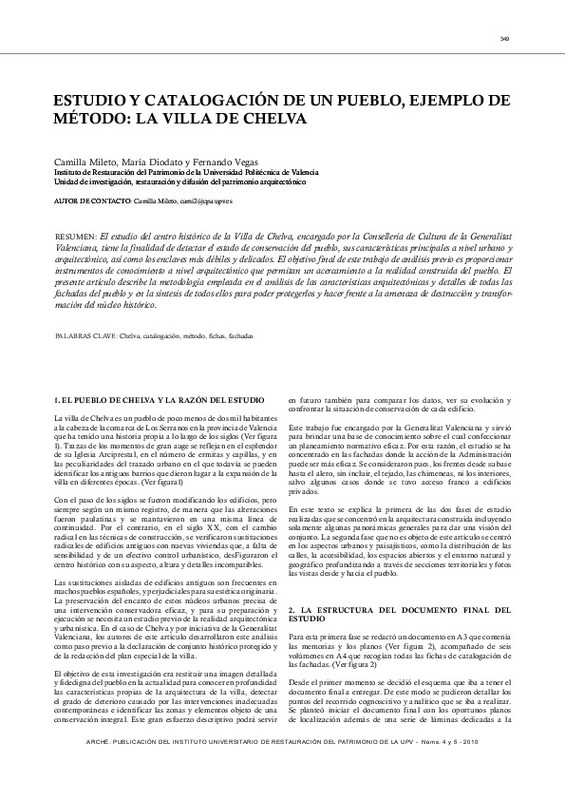JavaScript is disabled for your browser. Some features of this site may not work without it.
Buscar en RiuNet
Listar
Mi cuenta
Estadísticas
Ayuda RiuNet
Admin. UPV
Estudio y catalogación de un pueblo, ejemplo de método: la Villa de Chelva
Mostrar el registro sencillo del ítem
Ficheros en el ítem
| dc.contributor.author | Mileto, Camilla
|
es_ES |
| dc.contributor.author | Diodato, Maria
|
es_ES |
| dc.contributor.author | Vegas López-Manzanares, Fernando
|
es_ES |
| dc.date.accessioned | 2013-07-16T11:44:55Z | |
| dc.date.available | 2013-07-16T11:44:55Z | |
| dc.date.issued | 2010 | |
| dc.identifier.issn | 1887-3960 | |
| dc.identifier.uri | http://hdl.handle.net/10251/31153 | |
| dc.description.abstract | El estudio del centro histórico de la Villa de Chelva, encargado por la Consellería de Cultura de la Generalitat Valenciana, tiene la finalidad de detectar el estado de conservación del pueblo, sus características principales a nivel urbano y arquitectónico, así como los enclaves más débiles y delicados. El objetivo final de este trabajo de análisis previo es proporcionar instrumentos de conocimiento a nivel arquitectónico que permitan un acercamiento a la realidad construida del pueblo. El presente artículo describe la metodología empleada en el análisis de las características arquitectónicas y detalles de todas las fachadas del pueblo y en la síntesis de todos ellos para poder protegerlos y hacer frente a la amenaza de destrucción y transformación del núcleo histórico. | es_ES |
| dc.description.abstract | The survey of the historical center of Chelva, commissioned by the Consellería de Cultura of the Valencian Autonomous Government, has the purpose of detecting the conservation state of the village, its principal urban and architectural characteristics, as well as its most fragile and delicate places. The final aim of this work is to provide instruments of knowledge, through a preliminary analysis of the architecture, which will allow an approach to the constructive features of the village. The present article describes the method used in the analysis of these constructive and architectural features and details. With regard to this method, the survey of all the façades of Chelva and the synthesis of all of their characteristics led to the opportunity of protecting the entire village in order to slow down the destruction and transformation of the historical nucleus of the town. | es_ES |
| dc.format.extent | 8 | es_ES |
| dc.language | Español | es_ES |
| dc.publisher | Instituto Universitario de Restauración del Patrimonio de la UPV | es_ES |
| dc.relation.ispartof | Arché | es_ES |
| dc.rights | Reserva de todos los derechos | es_ES |
| dc.subject | Fachadas | es_ES |
| dc.subject | Fichas | es_ES |
| dc.subject | Método | es_ES |
| dc.subject | Catalogación | es_ES |
| dc.subject | Chelva | es_ES |
| dc.subject | Classification | es_ES |
| dc.subject | Method | es_ES |
| dc.subject | Catalogue | es_ES |
| dc.subject | Façades | es_ES |
| dc.subject.classification | CONSERVACION Y RESTAURACION DE BIENES CULTURALES (UPV) | es_ES |
| dc.title | Estudio y catalogación de un pueblo, ejemplo de método: la Villa de Chelva | es_ES |
| dc.title.alternative | Analysis and classification of a village, an example of method: la Villa de Chelva | es_ES |
| dc.type | Artículo | es_ES |
| dc.rights.accessRights | Abierto | es_ES |
| dc.contributor.affiliation | Universitat Politècnica de València. Instituto Universitario de Restauración del Patrimonio - Institut Universitari de Restauració del Patrimoni | es_ES |
| dc.description.bibliographicCitation | Mileto, C.; Diodato, M.; Vegas López-Manzanares, F. (2010). Estudio y catalogación de un pueblo, ejemplo de método: la Villa de Chelva. Arché. (4-5):349-356. http://hdl.handle.net/10251/31153 | es_ES |
| dc.description.upvformatpinicio | 349 | es_ES |
| dc.description.upvformatpfin | 356 | es_ES |
| dc.description.issue | 4-5 | |
| dc.identifier.eissn | 2445-1150 |






